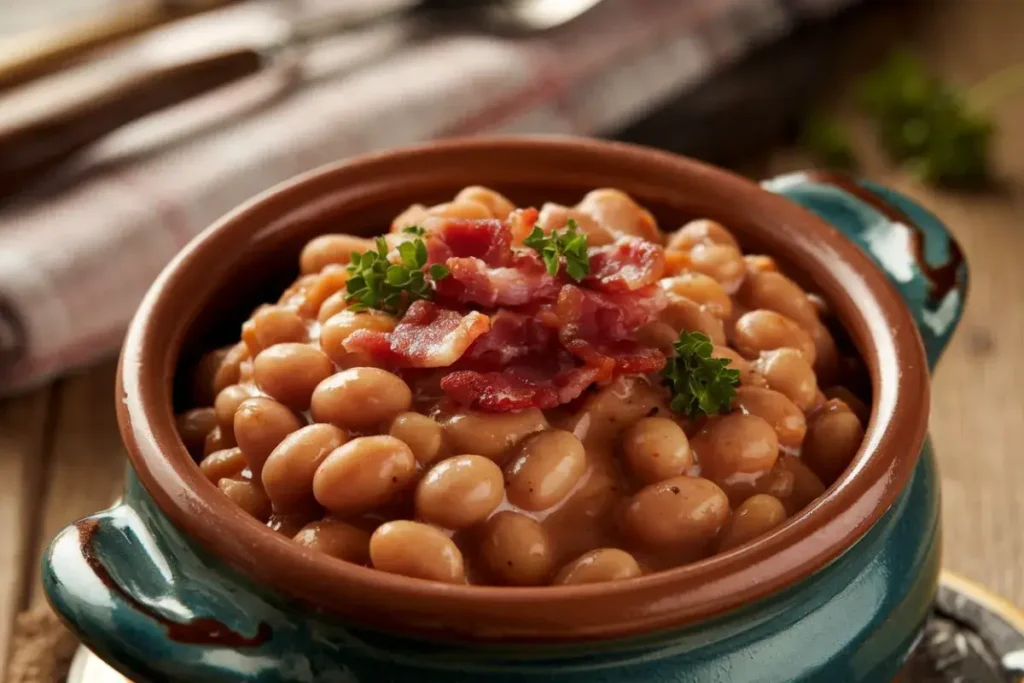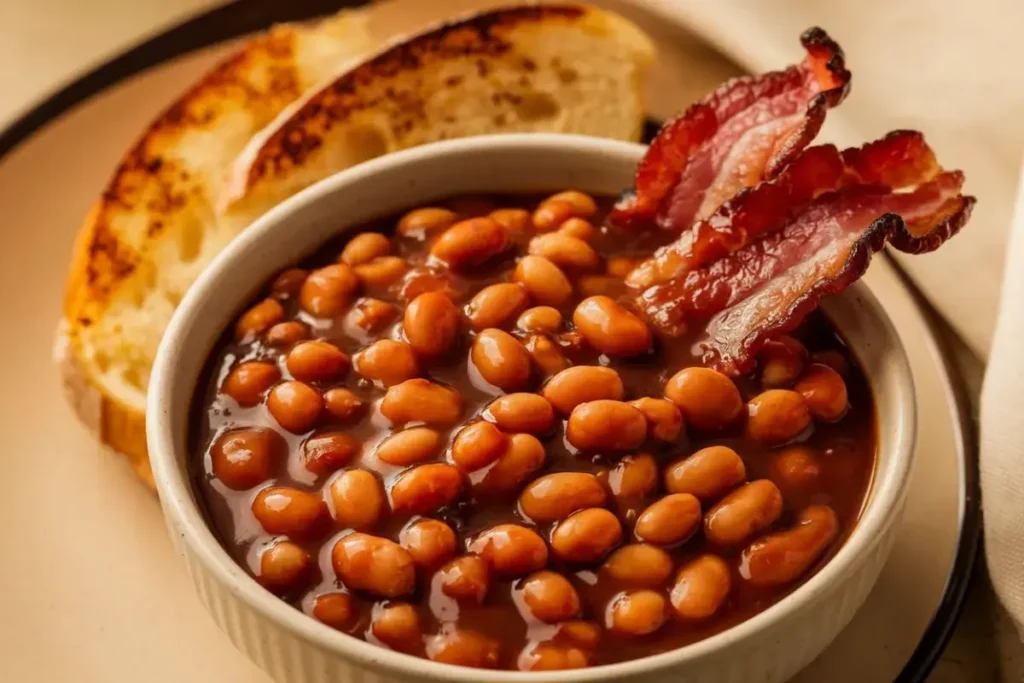Homemade baked beans recipe is a delicious, versatile dish perfect for any meal. Whether you’re serving it at a BBQ or enjoying it as a cozy side, making baked beans from scratch elevates the flavor and gives you control over ingredients. This easy recipe is packed with smoky, sweet, and savory flavors, making it a favorite for family gatherings or everyday dinners.
Another big reason to go homemade? Versatility! You can customize your beans to fit your preferences—whether you like them sweet and smoky, extra tangy, or loaded with bacon. With the right ingredients, you can easily create a recipe that’s healthier, tastier, and more tailored to your taste buds.
For example, making your beans in a slow cooker brings out deep flavors, and allows you to prepare them in advance for a big family dinner or gathering.
Ingredients You’ll Need for Homemade Baked Beans
To make a mouth-watering batch of baked beans, it’s essential to start with the right ingredients. Here’s a quick breakdown of the key items you’ll need:
Beans: Choosing the Right Type
- Navy beans are the classic choice for baked beans. These small, white beans soak up flavors beautifully and have a creamy texture when cooked.
- You can also use pinto beans or kidney beans for a heartier version, but note that the texture will vary slightly.
Sweeteners: Balancing the Flavor
The perfect baked beans are all about balance, especially when it comes to sweetness. Depending on your taste preference, you can use:
- Molasses: The traditional option, giving a rich, slightly bitter sweetness.
- Brown sugar: Adds warmth and depth, balancing out the tangy and smoky flavors.
- Maple syrup: A more natural sweetener, ideal if you prefer a lighter, more caramelized sweetness.
Smoky and Savory Additions
For that irresistible smoky flavor, adding a meat base is key. Some excellent options include:
- Smoked Beef bacon for a hearty, meaty flavor. For a rich, smoky taste, try serving baked beans with smoked turkey breast.
- Want to keep it vegetarian? Opt for liquid smoke or smoked paprika to achieve a similar effect without the meat.
You can also experiment with other spices like mustard powder or Worcestershire sauce to add complexity to your dish.
Tools You’ll Need for Cooking Baked Beans
The beauty of baked beans is their flexibility—you can prepare them using a variety of methods. However, having the right tools makes all the difference in achieving that perfect, tender bean texture and caramelized sauce.
Pots, Pans, and Slow Cookers
- If you’re using a Dutch oven, it’s perfect for stovetop cooking, then transferring to the oven for that rich baked flavor.
- For a hands-off approach, a slow cooker is a great option. Slow cooking beans over several hours allows the flavors to develop deeply and gives you a rich, thick sauce.
- Lastly, a regular stockpot works too, though it may require a bit more attention to ensure the beans don’t stick to the bottom.
Cooking Times and Techniques
- Slow cooking (on low for 6-8 hours) is ideal for deep flavor penetration.
- For a quicker method, you can simmer the beans on the stovetop for about 1.5 to 2 hours, though the flavors won’t be as concentrated as with slow cooking.
Step-by-Step Baked Beans Recipe

Now that you know the basics, let’s dive into the step-by-step baked beans recipe:
1: Preparing Your Beans
- Soaking dried beans: If you’re using dried beans, soak them overnight in plenty of water. This softens the beans and reduces cooking time. Drain and rinse them before use.
- Using canned beans: You can skip the soaking step if you’re using canned beans, but be sure to rinse them thoroughly to remove any excess sodium.
2: Creating the Flavor Base
- Start by sautéing onions, garlic, and smoked bacon in a large pot or Dutch oven. This step builds the foundational flavors for your baked beans.
- Add your sweeteners (molasses, brown sugar, or maple syrup) and tomato sauce, stirring until everything is well combined.
3: Simmering the Beans
- Once your base is ready, add the soaked (or canned) beans and mix them with the sauce.
- Pour in enough water or broth to cover the beans, and bring the mixture to a boil.
- Lower the heat to a simmer, cover the pot, and let the beans cook for about 1.5 to 2 hours, stirring occasionally.
4: Baking or Slow Cooking
- If you’re baking the beans, preheat your oven to 325°F (165°C). Transfer the pot to the oven and bake uncovered for 1 to 1.5 hours. This step helps caramelize the sauce, giving the beans that signature sticky texture.
- For slow cooker beans, set your cooker to low and let the beans simmer for 6-8 hours. The result? A thick, flavorful dish that practically makes itself.
Making baked beans from scratch doesn’t just taste better, it’s also a great way to control the ingredients and customize the recipe to your liking. Whether you’re a fan of a smoky, savory flavor or a sweet and tangy sauce, you can adjust the ingredients as you see fit. If you’re curious about how different bean types and techniques can affect your recipe, check out this helpful guide on the nutritional benefits of beans to ensure you’re making a meal that’s both delicious and good for you.
Tips for Perfect Baked Beans Every Time
Making the perfect baked beans comes down to a few essential techniques. While the process is straightforward, a few adjustments can elevate your dish from average to outstanding.
Don’t Skip the Soaking
- If you’re using dried beans, soaking is a must. It softens the beans and helps them cook more evenly. Soaking overnight is the best approach, but if you’re short on time, a quick-soak method works too. Simply boil the beans for two minutes, then let them sit in the hot water for an hour before draining.
Layering Flavors for Depth
- The secret to creating rich, flavorful baked beans is layering your flavors. Start by sautéing your savory base—onions, garlic, and bacon—and then slowly incorporate your sweeteners, such as molasses or brown sugar, and tangy elements like mustard or vinegar.
- Add acidic ingredients like vinegar or mustard toward the end of cooking to balance the dish. This step prevents the beans from becoming overly sweet or too rich.
Avoiding Common Mistakes
- Overcooking is one of the most common mistakes when making baked beans. Overcooked beans turn mushy and lose their texture, so keep an eye on your cooking time.
- Another issue is under-seasoning. Beans absorb a lot of flavor, so don’t be shy about adjusting your seasonings as you go. Taste-testing regularly ensures you achieve the perfect balance of sweetness, smokiness, and tanginess.
Different Ways to Customize Your Baked Beans
One of the best things about making your own baked beans is how customizable they are. You can easily adapt the recipe to your taste or dietary needs.
Adding Meats or Keeping It Vegetarian
- If you want to add a hearty, meaty flavor to your beans, options like smoked sausage or chorizo can be great additions alongside bacon. These meats provide extra richness and a deeper smoky taste.
- For a vegetarian version, simply omit the meat and add additional flavor using smoked paprika, liquid smoke, or chipotle powder. These spices will give you that deep, savory flavor without using animal products.
Adjusting for Dietary Needs
- For a gluten-free version of baked beans recipe, check that all of your ingredients—especially Worcestershire sauce and broth—are gluten-free.
- Need to reduce sodium? Opt for low-sodium beans, bacon, and broth. This keeps the dish healthier without losing any of the rich flavors.
- If you’re making vegan baked beans, replace meat with plant-based options like tempeh or tofu, and use vegan-friendly Worcestershire sauce or tamari.
Regional Variations of Baked Beans
Baked beans have developed different flavors depending on the region:
- Boston baked beans: Known for their sweet flavor, thanks to molasses and salt pork, these beans are a classic in New England cuisine.
- Southern-style baked beans: Typically made with BBQ sauce, these beans have a smokier, spicier flavor and often include bacon or sausage.
- British baked beans: A popular breakfast item, British beans are usually cooked in a tomato-based sauce and served on toast.
Serving Suggestions for Baked Beans

Once your homemade baked beans are ready, you’ll want to think about how best to serve them. The versatility of baked beans makes them a perfect side for many different dishes, but they can also be incorporated into main meals.
Best Side Dishes for Baked Beans
- Grilled meats like ribs, brisket, or chicken are perfect accompaniments to baked beans, especially for a BBQ meal.
- For a Southern-style meal, baked beans pair well with cornbread, coleslaw, and mac and cheese.
- In a British-inspired breakfast, serve baked beans on toast alongside eggs and sausages.
For a complete BBQ spread, baked beans pair perfectly with beef back ribs for a hearty meal.
Incorporating Baked Beans into Other Dishes
- Use baked beans as a base for a bean casserole. Simply layer the beans with cheese and breadcrumbs, then bake for a comforting dish.
- Serve baked beans on toast with a fried egg for a simple, protein-packed breakfast or brunch.
- Add them to a BBQ pulled pork sandwich for extra flavor and texture.
Storage and Reheating Tips for Baked Beans
One of the best things about baked beans is that they store and reheat beautifully. You can make a large batch and enjoy them over several days, or even freeze them for later use.
Refrigeration and Freezing
- Refrigeration: Baked beans recipe can be stored in the refrigerator for up to five days. Be sure to let them cool completely before transferring to an airtight container.
- Freezing: To store beans longer, freeze them in portion-sized containers. Baked beans will keep in the freezer for up to three months. When ready to use, simply thaw in the fridge overnight.
Reheating Without Losing Flavor
- When reheating, go low and slow. For the best results, reheat on the stove over low heat, stirring occasionally. If the sauce has thickened too much, you can add a splash of water or broth to loosen it.
- Frozen beans should be thawed completely before reheating. For convenience, you can microwave beans in short intervals, stirring in between, but be careful not to overheat them as they may become mushy.

